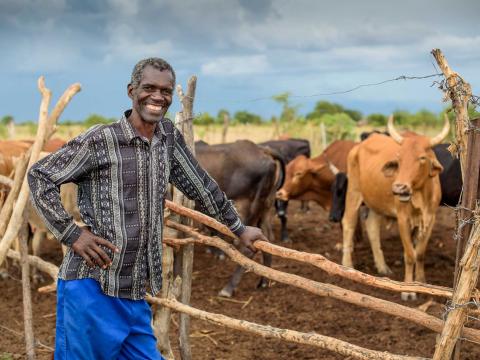Joseph the Dairy Farmer

On a recent trip to Zambia, I witnessed World Vision’s work to lift people out of poverty through a comprehensive community development effort. I was in the Magoye area of the Mazabuka District where World Vision has provided clean water sources of protected wells and boreholes.
This is a fairly remote area where people rely on subsistence farming primarily of growing corn. The land is suitable for dairy farming which can be more lucrative, but it’s so far from the local market that milk spoils during the journey. So, in the past, commercial dairy farming really wasn’t possible.
But that changed when World Vision worked with the local farmers to create the Munjile milk collection center. This is a cooperative owned by the local farmers that collects enough milk every day so that Parmalat, the large dairy product company, sends a big truck to collect it and take it to one of their major collection centers. The cooperative provides a reliable income from dairy farming that has tripled the income of many of the farmers, and literally lifted them out of poverty.
We watch a steady stream of farmers bicycling with their milk jugs to the collection facility. Many of these bicycles were provided through World Vision’s partnership with World Bicycle Relief and donated by the Annual Aspen Invitational Bicycle Ride called “Brake the Cycle”. It’s clear that water is essential for this effort as the collection facilities have to be kept clean and each farmer washes his milk jugs before returning home.
I learn from the local veterinarian that World Vision has also helped introduce new breeds of cattle that produce more milk than the traditional local breeds. The veterinarian reminds me that water is essential for good milk production, particularly during the dry season, when the cattle feed is dry. The cattle can drink 5 gallons of water a day so the World Vision water points have been essential for the new wealth in the community.
World Vision’s Vision Fund has been an important partner in this effort by providing loans to the farmers to purchase the better milk producing cattle as well as to buy some of the bicycles and insulated milk containers.
The highlight of our visit was spending time with Joseph Mchindu, one of the dairy farmers. Joseph is 60 years old and worked 27 years as a school teacher. He saved enough money from his teaching career to buy the farm and since he didn’t have a pension, he needs a source of income for his family. Joseph tells me that when he started, he didn’t really know if he’d have any luck with farming. He was stepping out in faith and relied on World Vision as well as the local community to teach him how to be a dairy farmer. He was afraid that he’d be the laughing stock of the community but now is proud that his single cow effort from 4 years ago has turned into a lucrative dairy farm with more than a dozen cows.
Joseph is eager to show us around. He never dreamed that he’d be highlighted as a model farmer in this community and is thrilled to introduce us to his family and his farm.
Joseph has a 10 minute bike ride to bring the milk to the collection facility, and tells me that the thinks of his family during the bike ride and how much better off they are now because of their higher income. He’s proud that he’s been able to send five of his children to college. He tells us that one of the most satisfying parts of his day is when his family gathers for the evening meal and makes plans of how they’re going to make the farm even better.
Joseph’s wife Annie tells me that the farming work is difficult and she works harder than when she was a housewife when Joseph was a school teacher. But, she tells me they are fulfilled. Annie says, “Yes, the work is hard but it helps give our life purpose and our family is happy and healthy”.
I’m inspired by seeing this work. The combination of readily available and clean water, improved farming practices, the milk collection cooperative, and the microloans have had a huge impact in this community. Poverty is being eliminated and the community has been transformed. And, even better, is that through our donors and partners, we’re doing similar work to lift millions of people out of poverty in sub-Saharan Africa. We believe that by continuing and expanding these efforts, that by 2030, we will eliminate extreme poverty in most of the areas where we work.






